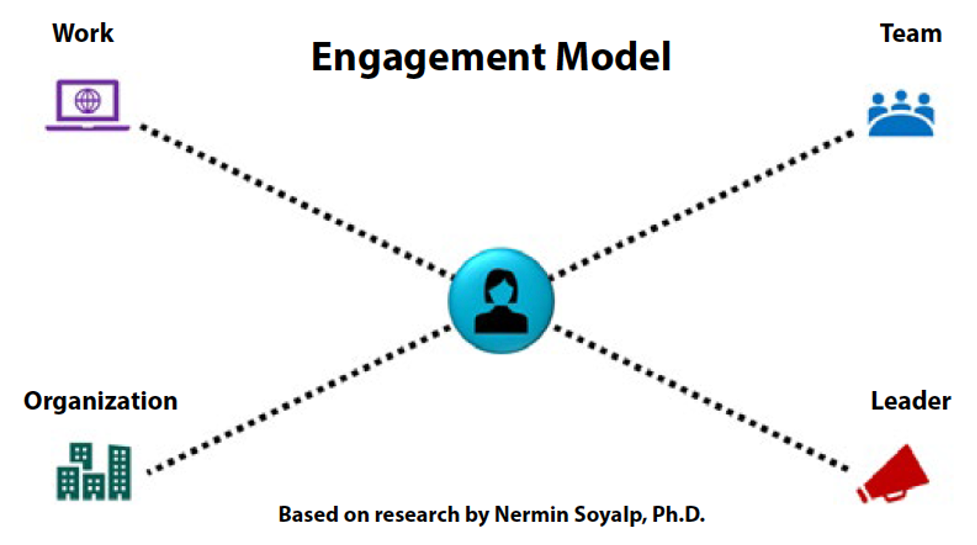Supporting Employee Engagement: Leading Remote Teams
By Nermin Soyalp, Ph.D.

Two years into the pandemic, engagement surveys—unsurprisingly—report low morale and decreased engagement for many organizations. Organizations have been inviting employees back to their offices. However, with Covid19 surges and employees enjoying working at home, many balk at returning to the office full-time. Working remotely is here to stay, and managers face the challenge of creating and supporting an engaged remote work environment.
This article focuses on engagement: what it is, how it works, and the leader’s role in increasing and maintaining employee engagement, especially when leading remotely. Barnes & Conti has redoubled our long-standing commitment to supporting organizations, their leaders, and team members as they develop and maintain engaged remote workplaces. This article will identify factors that contribute to high engagement and how we can create processes to address obstacles to engagement.
Definition: Employee engagement means that team members find meaning in their work and bring their full potential and energy to it. Organizations and teams with engaged employees demonstrate better performance, collaborative relationships, and committed participation. Organizational and team resilience requires a high level of engagement across the organization. Leaders need to understand how engagement works and how to increase the level of engagement by individuals and teams.
How do you know when employees are engaged?
Research suggests that engaged employees are more curious, dependable, enthusiastic, adaptive, cooperative, committed, confident, attentive, and resourceful. These traits are not static and may depend on employees’ life circumstances and/or priorities. Less engaged team members may have lost interest or effectiveness, while more engaged team members showed a more adaptive and resourceful mindset – helping their team to respond productively during unprecedented times.
Four Key Components to Employee Engagement
 My experience with employee engagement interventions demonstrates that engagement is an ongoing process which depends on an individual’s interaction with four aspects of their job: the work itself, the team, the leadership, and the overall organization.
My experience with employee engagement interventions demonstrates that engagement is an ongoing process which depends on an individual’s interaction with four aspects of their job: the work itself, the team, the leadership, and the overall organization.
1: The Nature of Work
Work-related components include team members’ sense of:
- Autonomy
- Dedication to work
- Sufficient challenge
- Agreement on reasonable workload (avoiding potential burnout with too much or boredom with too little)
- Their own competence to do the work
- Meaning and purpose of the work
- Real progress toward achieving goals.
Working remotely presents technical challenges; e.g. poor connectivity, improper software or inadequate equipment. Frustrations arise when individuals are trying to find a document or reach a key team member for help. Leaders need to be aware of and encourage group norms and processes that enable employees to report their progress, issues, and obstacles to other team members frequently. Some groups find it helpful to have huddle meetings before they start their workdays. Others have meetings scheduled throughout the week for check-ins and have backup communications—e.g. text or chat—in the case of internet connectivity issues. Many use team software enabling them to connect and share information and resources.
Even with technology and process support, team members need to make more of an effort to communicate with colleagues and other employees, since spontaneous “water cooler” meetings or informal visits to one another’s physical workspace are no longer options.
2: Team Engagement
Team engagement is the willful, voluntary collaboration between and among team members. Team members may work independently on their individual tasks. However, they require the tools and the willingness to come together to accomplish group projects, clarify deadlines, and manage interdependencies.
Team components that impact members’ engagement at work include:
- Group acceptance
- Others’ mindsets and competence (one member’s high engagement level could stimulate energy and a sense of engagement for others)
- Being supported by others
- A sense of group cohesion.
In summary, if members trust other team members’ competence, they know they can reach out to one another or answer questions or request help. If they enjoy working together, a strong likelihood of establishing better team engagement and a sense of cohesion exists.
3: Leadership Effectiveness
The most effective leaders guide their employees toward results rather than micromanaging or focusing on means versus ends. They are clear about expectations and/or deliverables. They see that their role, in part, is to remove barriers.
Some ways that leaders effectively support the engagement of their team members include:
- Clarity
- Communication
- Leadership mindset among members
- Offers and delivery of support
Clarity is one of the keys to supporting engagement at work, especially for remote employees. Team members perform better when there is clarity about employer expectations. They are aware of the key performance metrics that may impact their role or compensation, and have a clear sense of project deliverables and goals.
Effective leaders of remote teams communicate with members regularly, both 1:1 and in meetings. Meetings can be formal/structured or informal “hangouts” in a team chat room. Showing interest in team members’ well-being helps to develop high-trust relationships between leader and members and encourages engagement.
The best leaders encourage team members to lead. This results in empowered team members who take the initiative that advances both the organization’s work and their careers. When employees state a problem, effective leaders resolve the problem together with them, rather than solve it independently.
Leaders who guide teams toward results—rather than micromanaging— show the following behaviors. They:
- Make their team members part of the solution.
- Are flexible in their approach.
- Provide training and learning opportunities when team members need them.
- Remain open and supportive with their team (e.g., listening, giving, and receiving feedback).
- Establish good two-way communication with team members.
4: Organizational Support and Purpose
Organizational engagement has two components: organizational support and organizational purpose.
Engagement with organizational purpose is characterized by:
- Believing in what the company does: its mission, vision, values, and contribution to society.
- Knowing how one’s work connects to the organization’s overall purpose and having a sense of pride and meaning because of that connection.
Organizational support is experienced when:
- The employee feels that someone in leadership encourages their development.
- Opportunities and structures are available to them to help them excel in their work.
When employees are disengaged at this level, the organizational culture, systems, and structures may need addressing. Are gossiping, bullying, and exclusion are part of the organizational culture? Or are job advancement or training opportunities not available to team members? Employees may be discouraged because they feel powerless to change the culture, systems, or structures. If your team members have brought up an issue up in a constructive way, yet nothing has changed, or if they’re singled out as “problem employees,” they may become less engaged and eventually leave the company. These issues require systemic leadership and interventions, as well as clear communication.
In summary, people can be engaged with their work, with their team, with their leader, and/or with their organization. Ideally, the work itself is meaningful, the team is high-performing, the leader is inspirational, and the organization is doing the kind of work that is aligned with the individual’s personal values. Of course, not all of these will always be true, but they can interact and keep team members focused and engaged.
Reflection Questions
- How engaged do you feel with these areas? (work, team, leadership, and organizational)
- What keeps you engaged, and what would help you be more engaged?
If you are leading a team:
- Thinking about your team members, how engaged do you think they are in each of these areas?
- How can you help them to be more engaged?
Please feel free to post your comments.

Leave a Reply
You must be logged in to post a comment.